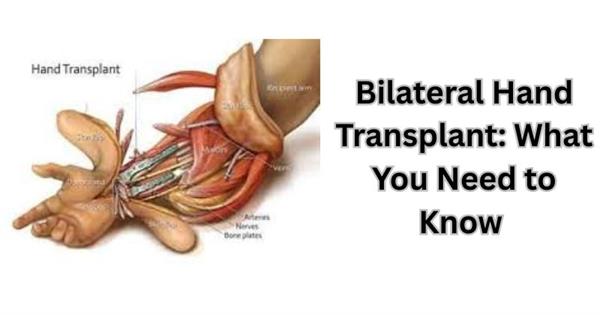Bilateral Hand Transplant: What You Need to Know

In the world of modern medicine, there are advancements that seem nothing short of miraculous. One such advancement is the bilateral hand transplant. This highly complex procedure, although still rare, offers hope to individuals who have lost both of their hands due to injury, disease, or congenital conditions. The process not only restores lost functionality but also offers patients a sense of normalcy and a better quality of life. If you or a loved one is considering a hand transplant, it’s essential to understand the procedure, its risks, and its costs. This blog will dive into the bilateral hand transplant, covering what you need to know.
What Is a Bilateral Hand Transplant?
A bilateral hand transplant is a type of surgery where both hands are transplanted from a donor to a recipient. Unlike a single hand transplant, which involves only one hand, a bilateral hand transplant addresses the loss of both hands. The surgery is incredibly complex and involves the careful reattachment of bones, blood vessels, nerves, tendons, and muscles. A successful hand transplant requires a team of highly skilled surgeons, including plastic and orthopedic surgeons, as well as other medical professionals.
The need for bilateral hand transplants arises primarily from severe trauma, congenital disabilities, or diseases like amputation due to accidents or infections. Individuals who lose both hands experience a dramatic decrease in their quality of life, which can affect everything from daily activities to mental health. For these patients, a hand transplant can offer not only functional restoration but also psychological benefits.
How Does a Bilateral Hand Transplant Work?
The procedure for a bilateral hand transplant is similar to other organ transplants but is much more intricate. Here’s an overview of the key steps involved in the process:
- Pre-Transplant Assessment: Before the transplant, the recipient undergoes extensive testing to ensure they are physically and mentally prepared for the procedure. This includes blood tests, imaging studies, and psychological evaluations to ensure that they understand the commitment to lifelong immunosuppressive therapy.
- Donor Matching: Finding a donor with a compatible blood type, tissue match, and hand size is a crucial step. Given the complexity of the surgery, the donor hands must also come from someone who has recently passed away, and the transplant must occur within a short time window.
- The Transplant Procedure: The bilateral hand transplant itself can take many hours, often spanning 12-18 hours. During the surgery, the surgeons will reattach the bones, blood vessels, nerves, muscles, and tendons of the donor hands to the recipient’s arm stumps. The goal is to restore both form and function.
- Post-Surgery Rehabilitation: Recovery from a hand transplant is a long-term commitment. After surgery, the patient undergoes intensive physical therapy to re-establish nerve function and gain muscle strength in the newly transplanted hands. This stage is critical as it determines the success of the transplant in the long run.
- Immunosuppressive Therapy: Like any other organ transplant, a hand transplant requires the recipient to take immunosuppressive drugs for the rest of their life. These medications prevent the body from rejecting the transplanted tissue but also make the individual more susceptible to infections.
Bilateral Hand Transplant Cost
A bilateral hand transplant is not a simple or inexpensive procedure. The cost of the surgery varies depending on several factors, including the location of the hospital, the complexity of the case, and the healthcare system of the country in question. However, bilateral hand transplant cost can run into several hundred thousand dollars.
This hefty price tag includes the cost of the surgical team, hospital stay, donor matching, organ procurement, post-operative care, and long-term medications. The bilateral hand transplant cost may also involve the costs of rehabilitation, which can extend over many months or even years. The financial burden can be overwhelming, especially when considering that the patient will need lifelong immunosuppressive therapy.
Many healthcare systems do not cover the full bilateral hand transplant cost, which can further complicate access to this life-changing procedure. As such, patients considering this type of surgery must thoroughly explore insurance options, financial assistance programs, and other means to cover the expense.
Risks and Complications of Hand Transplants
Although a hand transplant offers significant benefits, it is important to understand that it is not without risks. As with any major surgery, there are potential complications, such as:
- Rejection: The body may attempt to reject the transplanted hands, especially if the recipient’s immune system is not properly suppressed. Rejection can occur at any time after the transplant.
- Infection: Immunosuppressive drugs make the body more susceptible to infections, so patients must be vigilant about hygiene and follow all medical guidelines to minimize this risk.
- Functional Limitations: While a hand transplant restores a degree of function, it may not provide the same level of dexterity as a biological hand. Some recipients experience reduced strength or range of motion in their new hands.
- Psychological Impact: After the transplant, there can be significant emotional and psychological challenges. Some patients may struggle with the psychological aspects of receiving a hand transplant, such as the impact on their body image or the emotional adjustment to using a transplanted hand.
The Future of Bilateral Hand Transplants
While still in its infancy, the field of hand transplants holds promise for the future. Researchers are continually improving techniques and exploring ways to make the procedure safer, less invasive, and more successful. The integration of cutting-edge technologies, such as robotic surgery and stem cell therapy, could further enhance the outcomes of these transplants in the years to come.
Conclusion
A bilateral hand transplant is a remarkable procedure that offers hope to individuals who have lost both of their hands. While the procedure is complex and expensive, the potential benefits for patients in terms of both function and quality of life are immense. The bilateral hand transplant cost is significant, but as the field advances, it is likely that these types of transplants will become more accessible.
If you or someone you know is considering a hand transplant, it’s essential to consult with a specialist who can provide guidance on the procedure, risks, and costs involved. With careful consideration and planning, this procedure could significantly change the life of someone who has been living without hands.
for more(click here)





